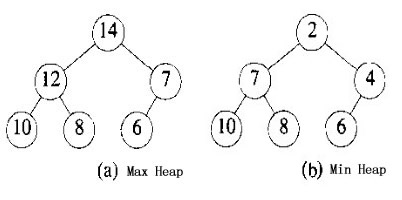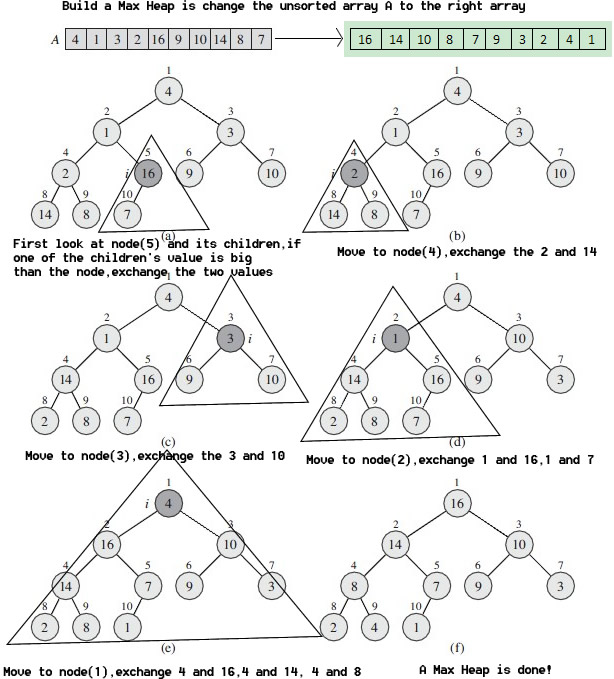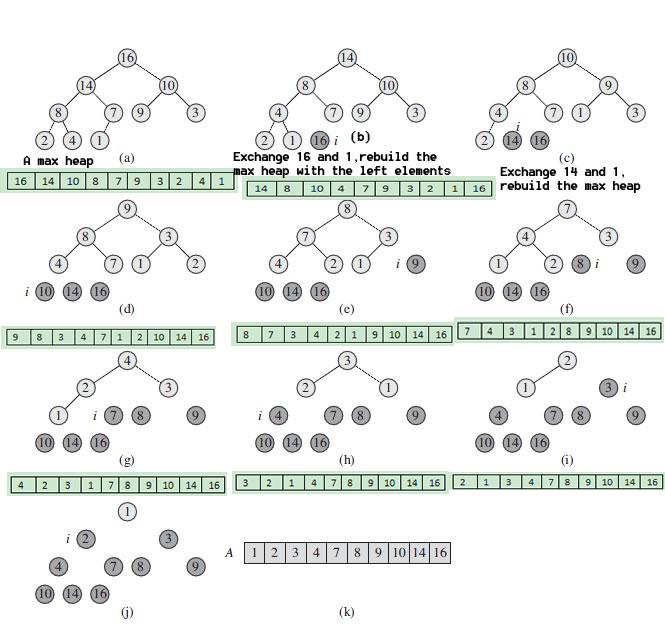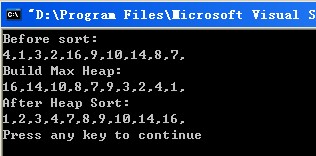HeapSort C++
Heaps
Heap Definition
A max tree(min tree) is a tree in which the value in each node is greater(less) than or equal to those in its children(if any)
Building a max heap
Look at below figure, we adjust elements in a array, swap some elements, at last we have a max heap. The progress begin from the last smallest heap. If it is a illegal max heap, we swap elements to let it became a legal max heap. Look at (b) in the figure. Three elements 2, 14, 8 is not a max heap. We adjust the tree by swaping 2 and 14, then it is a max heap, looking at (c) in the figure.
1 2 3 4 5 6 7 8 9 10 11 12 13 14 15 16 17 18 19 20 21 22 23 24 25 26 27 28 29 30 31 | int a[10]={4,1,3,2,16,9,10,14,8,7};for(int i = 4; i >= 0; i--){ int leftIndex = i * 2 + 1; // i is the node index, so the node's left child's index is i * 2 + 1 // notice: in an array , 0 is the first index. while(leftIndex < n){ // if we do not have the left child, quit the loop int left = a[leftIndex]; //---------------find the max element in the three element, and exchange the two elements. begin---------------------- int maxIndex = i; // In a 3 elements heap, we assume the node is the max element. if(left > a[i]){ // If node's left child value is big than node maxIndex = leftIndex; // we change the maxIndex value to left child's index } if(leftIndex + 1 < n && a[leftIndex + 1] > a[maxIndex]){ //if we have the right child, and right child's value is big // than the max value of the two(node and its left child) maxIndex = leftIndex + 1; // we change the maxIndex value to right child's index } if(maxIndex != i){ // if some child of the node is big than the node's value swap(a[i], a[maxIndex]); // we exchange the two elements }else{ break; } //---------------find the max element in the three element, and exchange the two elements. end ---------------------- i = maxIndex; // Because we exchange some value,so we will look down from the element we had changed, // So we change the node index to the max value's index,change the left index leftIndex = 2 * i + 1; } } |
HeapSort From a max heap
First, we swap the first element and last element, and rebuild the max heap of the elments except the last element. To do such thing in the new max heap until there is only one element.
1 2 3 4 5 6 7 | int a[10]={4,1,3,2,16,9,10,14,8,7};BuildMaxHeap(a, 10);// build max heap// heap sortfor(int i = 9; i >= 1;i--){ swap(a[0],a[i]); MaxHeapify(a, 0, i); // rebuild max heap } |
1 2 3 4 5 6 7 8 9 10 11 12 13 14 15 16 17 18 19 20 21 22 23 24 25 26 27 28 29 30 31 32 33 34 35 36 37 38 39 40 41 42 43 44 45 46 47 48 49 50 51 52 53 54 55 56 57 58 59 60 61 62 63 64 65 66 67 68 69 70 71 72 73 74 75 76 77 78 79 80 81 82 83 84 85 86 87 88 89 90 91 92 93 94 95 96 97 98 99 100 101 102 103 104 105 106 107 108 109 110 111 112 113 | // HeapSort.cpp : Defines the entry point for the console application.//#include "stdafx.h"#include <iostream>using namespace std;//A easy version, but it is not the best one./*template <class T>void MaxHeapify(T a[], int i, int n){ int leftIndex = i * 2 + 1; // i is the node index, so the node's left child's index is i * 2 + 1 // notice: in an array , 0 is the first index. while(leftIndex < n){ // if we do not have the left child, quit the loop int left = a[leftIndex]; //---------------find the max element in the three element, and exchange the two elements. begin---------------------- int maxIndex = i; // In a 3 elements heap, we assume the node is the max element. if(left > a[i]){ // If node's left child value is big than node maxIndex = leftIndex; // we change the maxIndex value to left child's index } if(leftIndex + 1 < n && a[leftIndex + 1] > a[maxIndex]){ //if we have the right child, and right child's value is big // than the max value of the two(node and its left child) maxIndex = leftIndex + 1; // we change the maxIndex value to right child's index } if(maxIndex != i){ // if some child of the node is big than the node's value swap(a[i], a[maxIndex]); // we exchange the two elements }else{ break; } //---------------find the max element in the three element, and exchange the two elements. end ---------------------- i = maxIndex; // Because we exchange some value,so we will look down from the element we had changed, // So we change the node index to the max value's index,change the left index leftIndex = 2 * i + 1; }}*/ //The best one.template <class T>//adjust elements from i to n.void MaxHeapify(T a[], int i, int n) { int leftIndex, node; node = a[i]; leftIndex = 2 * i + 1; while (leftIndex < n) { //---------- finding a max element in left child and right child-------------- if (leftIndex + 1 < n && a[leftIndex + 1] > a[leftIndex]) leftIndex++; //---------- finding a max element in left child and right child-------------- if (a[leftIndex] <= node) break; a[i] = a[leftIndex]; i = leftIndex; leftIndex = 2 * i + 1; } a[i] = node; } template <class T>void BuildMaxHeap(T a[], int n){ for(int i = n/2 - 1; i >= 0; i--){ MaxHeapify(a, i ,n); }}template <class T>void HeapSort(T a[], int n){ for(int i = n - 1; i >= 1;i--){ swap(a[0],a[i]); MaxHeapify(a, 0, i); // rebuild max heap }}template <class T>void PrintfNum(T a[], int n);int main(int argc, char* argv[]){ const int NUM = 10; int a[NUM]={4,1,3,2,16,9,10,14,8,7}; cout << "Before sort:" << endl; int flag; PrintfNum(a, NUM); cout << "Build Max Heap:" << endl; BuildMaxHeap(a, NUM);// building a max heap PrintfNum(a, NUM); cout << "After Heap Sort:" << endl; HeapSort(a, NUM); PrintfNum(a, NUM); return 0;}template <class T>void PrintfNum(T a[], int n){ for(int i = 0; i < n; i++){ cout << a[i] << ","; } cout << endl;} |
 http://www.easycpp.com/?p=15
http://www.easycpp.com/?p=15



【推荐】国内首个AI IDE,深度理解中文开发场景,立即下载体验Trae
【推荐】编程新体验,更懂你的AI,立即体验豆包MarsCode编程助手
【推荐】凌霞软件回馈社区,携手博客园推出1Panel与Halo联合会员
【推荐】轻量又高性能的 SSH 工具 IShell:AI 加持,快人一步
· 记一次 .NET某固高运动卡测试 卡慢分析
· 微服务架构学习与思考:微服务拆分的原则
· 记一次 .NET某云HIS系统 CPU爆高分析
· 如果单表数据量大,只能考虑分库分表吗?
· 一文彻底搞懂 MCP:AI 大模型的标准化工具箱
· 7 个最近很火的开源项目「GitHub 热点速览」
· DeepSeekV3:写代码很强了
· 博客园2025新款「AI繁忙」系列T恤上架
· 记一次 .NET某固高运动卡测试 卡慢分析
· Visual Studio 2022 v17.13新版发布:强化稳定性和安全,助力 .NET 开发提